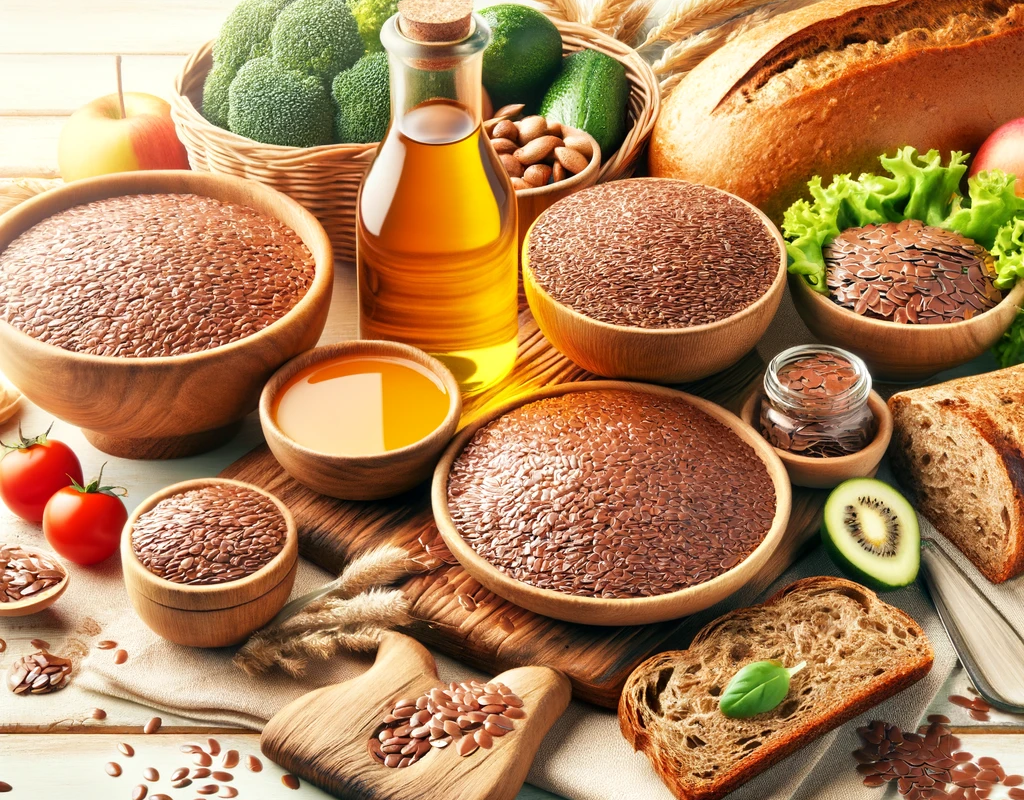Flax seeds, though tiny, pack a nutritional punch that has been recognized throughout history. These seeds have been used for thousands of years, not just as food but also for their medicinal properties. Ancient civilizations valued flax seeds for their health benefits, and today, they are celebrated in health and wellness circles for their versatility and nutrient density.
In the modern health landscape, flax seeds are lauded for their rich content of omega-3 fatty acids, fiber, and lignans, making them a superfood in the truest sense. They are increasingly being incorporated into various diets, from vegan to ketogenic, due to their wide array of health benefits. This resurgence in popularity is backed by scientific research, further cementing their status as a staple in healthy diets.
This article aims to provide a comprehensive overview of flax seeds, from their nutritional makeup to their numerous health benefits, and how they can be easily incorporated into everyday meals. Whether you are new to flax seeds or looking to deepen your knowledge, this guide will offer valuable insights into this ancient superfood.
1. Nutritional Profile of Flax Seeds
1.1 Essential Nutrients
Flax seeds are a rich source of alpha-linolenic acid (ALA), a type of omega-3 fatty acid that is essential for heart health and cognitive function. Unlike other plant-based sources of protein, flax seeds provide a complete protein, containing all nine essential amino acids. This makes them an excellent protein source, especially for vegetarians and vegans.
The seeds are also high in dietary fiber, both soluble and insoluble, which aids in digestion and maintaining a healthy gut microbiome. Soluble fiber helps to lower cholesterol and regulate blood sugar levels, while insoluble fiber aids in bowel regularity. Additionally, flax seeds are abundant in lignans, which are phytoestrogens known for their antioxidant properties.
Besides these, flax seeds are a good source of several vitamins and minerals. They are rich in thiamine (vitamin B1), essential for energy metabolism, and contain significant amounts of magnesium, which is crucial for bone health and muscle function. The presence of minerals like potassium and iron further enhances their nutritional value.
1.2 Comparison with Other Seeds
Compared to other popular seeds like chia or pumpkin seeds, flax seeds stand out primarily for their high omega-3 content. While chia seeds also contain omega-3s, flax seeds have a higher proportion of ALA. This makes them particularly beneficial for heart health and in reducing inflammation.
In terms of fiber, flax seeds again outperform many other seeds. The high fiber content is excellent for digestive health and can help in weight management by promoting a feeling of fullness. Furthermore, the unique balance of soluble and insoluble fibers in flax seeds is not commonly found in other seeds.
However, it’s important to note that each type of seed has its unique nutritional profile and health benefits. For instance, pumpkin seeds are rich in zinc and iron, while sesame seeds are a good source of calcium. Therefore, incorporating a variety of seeds into your diet is beneficial for obtaining a wide range of nutrients.
2. Health Benefits of Flax Seeds
2.1 Cardiovascular Health
Flax seeds are highly beneficial for heart health. Their high omega-3 fatty acid content helps reduce inflammation in the body, which is a key risk factor for heart disease. Omega-3s also contribute to the maintenance of normal blood cholesterol levels, further protecting the heart.
Regular consumption of flax seeds has been linked to lower blood pressure. The lignans in flax seeds may also help reduce the risk of atherosclerosis, a condition characterized by the hardening and narrowing of the arteries, by preventing the buildup of plaque in arterial walls.
In addition to these benefits, the soluble fiber in flax seeds aids in lowering bad LDL cholesterol levels in the blood. This can lead to a reduced risk of heart diseases, including heart attacks and strokes. Therefore, incorporating flax seeds into your diet can be a simple yet effective way to support heart health.
2.2 Digestive Health
The fiber in flax seeds plays a significant role in digestive health. It helps in promoting regular bowel movements and preventing constipation. Moreover, the fiber in flax seeds can help in managing symptoms of various digestive conditions, such as irritable bowel syndrome (IBS).
Flax seeds are also known for their prebiotic effects, meaning they can help nourish the beneficial bacteria in the gut. A healthy gut microbiome is essential for overall health, as it aids in digestion, boosts the immune system, and even impacts mood and mental health.
Additionally, the anti-inflammatory properties of flax seeds can be particularly beneficial for those suffering from inflammatory bowel diseases such as Crohn’s disease or ulcerative colitis. By reducing inflammation in the digestive tract, flax seeds can help alleviate some of the discomfort associated with these conditions.
2.3 Diabetes Management
Flax seeds can be a valuable dietary addition for those managing diabetes. Their high fiber content slows down the digestion of sugars, which helps in maintaining steady blood sugar levels. This slow release of glucose into the bloodstream can prevent spikes in blood sugar, which is crucial for diabetes management.
The ALA in flax seeds has also been shown to improve insulin sensitivity. Improved insulin sensitivity means the body can use insulin more effectively, which is beneficial for people with type 2 diabetes or at risk of developing this condition.
Moreover, the lignans in flax seeds may also play a role in diabetes management. Some studies suggest that lignans can help reduce the risk of type 2 diabetes by improving blood sugar control. However, more research is needed to fully understand this potential benefit.
2.4 Cancer Prevention
Flax seeds have shown potential in reducing the risk of certain types of cancer, particularly breast and prostate cancer. This is primarily attributed to their high content of lignans, which have estrogenic and antioxidant properties.
Lignans are phytoestrogens, plant compounds that can mimic the hormone estrogen in the body. They can have either estrogenic or anti-estrogenic effects, which can be beneficial in preventing hormone-related cancers. For instance, they may help in reducing the risk of breast cancer by altering estrogen metabolism.
Additionally, the omega-3 fatty acids in flax seeds may also contribute to their cancer-fighting properties. Omega-3s are known to inhibit the growth of tumor cells and reduce inflammation, which can be a contributing factor in cancer development.
2.5 Other Potential Benefits
Beyond the major health benefits, flax seeds offer several other advantages. They can be a useful tool in weight management, as their high fiber content helps promote satiety, reducing overall calorie intake.
The anti-inflammatory properties of flax seeds make them beneficial for reducing the risk of chronic diseases beyond heart disease and diabetes. Inflammation is a key factor in many chronic conditions, and the omega-3 fatty acids in flax seeds can help mitigate this.
Moreover, the antioxidants in flax seeds, particularly lignans, offer protection against oxidative stress and free radical damage. This can contribute to better overall health and may even slow down the aging process. The antioxidants can also support immune function, making the body more resilient against infections and diseases.
3. How to Incorporate Flax Seeds into Your Diet
3.1 Forms of Flax Seeds
Flax seeds are versatile and can be consumed in various forms. Whole flax seeds can be added to salads, yogurts, and cereals for a crunchy texture. However, it’s important to note that whole flax seeds may pass through the digestive system without being fully digested, which can limit the absorption of their nutrients.
Ground flax seeds, also known as flaxseed meal, offer more nutritional benefits as the body can easily absorb the nutrients. They can be blended into smoothies, mixed into oatmeal, or used as a thickening agent in sauces and soups.
Flaxseed oil is another popular form, rich in ALA but lacking in fiber and lignans. It can be used in salad dressings or drizzled over cooked dishes, but it should not be used for high-temperature cooking as it can become unstable.
3.2 Culinary Uses
Flax seeds are incredibly versatile in the kitchen. They can be a nutritious addition to breakfast foods like oatmeal, yogurt, or smoothie bowls. Sprinkling ground flax seeds over these dishes can boost their nutritional value without significantly altering the taste.
In baking, ground flax seeds can be used as an egg substitute, which is particularly useful for vegan recipes. Mixing one tablespoon of ground flax seeds with three tablespoons of water can create a mixture that has a similar consistency to an egg and can help bind ingredients together.
Flax seeds can also enhance the nutritional content of smoothies and drinks. Adding a tablespoon of ground flax seeds to a smoothie not only thickens it but also adds healthy fats and fiber, making the smoothie more filling and nutritious.
3.3 Recipes
To get started with incorporating flax seeds into your diet, try a simple flaxseed smoothie. Blend together a banana, a handful of berries, a cup of almond milk, and a tablespoon of ground flax seeds for a nutritious and delicious start to your day.
For those who enjoy baking, homemade flaxseed bread can be a healthy and satisfying option. Combine ground flax seeds with whole wheat flour, yeast, water, and a bit of honey to create a wholesome and fiber-rich bread.
A salad dressing with flaxseed oil can be a quick and easy way to add flax seeds to your meals. Whisk together flaxseed oil, lemon juice, garlic, and herbs for a flavorful dressing that can be drizzled over any salad.
4. Considerations and Potential Side Effects
4.1 Recommended Daily Intake
While flax seeds are beneficial, it’s important to consume them in moderation. The recommended daily intake is generally around one to two tablespoons of ground flax seeds. Exceeding this amount can lead to digestive issues due to their high fiber content.
4.2 Possible Side Effects
Some individuals may experience mild side effects from consuming flax seeds, such as bloating, gas, or diarrhea. These are typically due to the high fiber content and usually subside as the body adjusts. It’s also important to consume plenty of water when increasing fiber intake.
Flax seeds can have a blood-thinning effect due to their omega-3 fatty acid content. Therefore, individuals taking blood-thinning medications or those with bleeding disorders should consult their healthcare provider before adding flax seeds to their diet.
4.3 Special Considerations for Certain Groups
Pregnant and breastfeeding women should consult their healthcare provider before adding flax seeds to their diet. While flax seeds are generally safe, their phytoestrogen content may have effects that need to be considered in these populations.
Individuals with certain health conditions, such as bowel obstructions or hormone-sensitive cancers, should also seek medical advice before consuming flax seeds. Additionally, anyone with allergies to flax seeds or other seeds should avoid them.
Conclusion
Flax seeds are a versatile and nutrient-rich food that can offer a range of health benefits. Whether used for their heart-healthy fats, digestive benefits, or as a plant-based protein source, they can be an excellent addition to any diet. Experimenting with different ways to incorporate flax seeds into your meals can be both enjoyable and beneficial for your health.
We hope this guide inspires you to explore the many uses of flax seeds and experience the numerous health benefits they offer. Remember, as with any dietary change, it’s important to listen to your body and adjust according to your individual needs and preferences.




